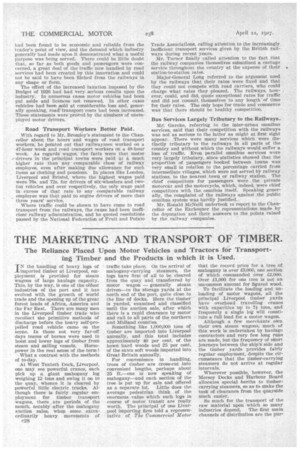THE MARKETING AND TRANSPORT OF TIMBER.
Page 50

Page 51

If you've noticed an error in this article please click here to report it so we can fix it.
The Reliance Placed Upon Motor Vehicles and Tractors for Transport lug Timber and the Products in which it is Used.
IN the handling of heavy, logs of imported timber at Liverpool, employment is provided for steam wagons of large haulage capacity. This, by the way, is one of the oldest industries of the port and it has evolved with the growth of world trade and the opening up of the great forest lands of Africa, America and the Far East. There are many men in the Liverpool timber trade who recollect the primitive methods of discharge before the heavy self-propelled road vehicle came on the scene. In those not very far-off days teams of horses were used to hoist and lower logs of timber from steam and sailing vessels. Horsepower in the real sense of the term!
• What a contrast with the methods of to-day.
At West Toxteth Dock, Liverpool, one may see powerful cranes, each pick up a giant mahogany log weighing 12 tons and swing it on to the quay, whence it is cleared by powerful little electric trucks. Although there is fairly regular employment for timber transport wagons, there are periods of the month, notably after the mahogany auction sales, when some extraordinarily heavy movements of c28 traffic take place. On the arrival of mahogany-carrying steamers, the logs have first of all to be cleared from the quay and transferred by motor wagon — generally steam driven—to the storage yards at the north end of the port, quite close to the line of docks. Here the timber is yarded, examined and classified until the auction sale, after which there is a rapid clearance by motor and rail to all parts of the northern and Midland counties.
Something like 1,000,000 tons of timber are imported into Liverpool annually, and this total includes approximately 40 per cent. of the hewn hard woods and 25 per cent. of the sawn soft woods imported into Great Britain annually.
For convenience in handling, trees of timber are cross-cut into convenient lengths, perhaps about 25 ft.—one is now speaking of mahogany—and each section of the tree is put up for sale and offered as a separate lot. Little does the average pedestrian think of the enormous value which such logs in course of motor transit are really worth. The principal of one Liverpool importing firm told a representative of The Commercial Motor
that the record price for a tree of mahogany is over £3,000, one section of which commanded over £2,000. Over £1,000 for one tree is not an uncommon amount for figured wood.
To facilitate the loading and unloading of motor wagons, all the principal Liverpool timber yards have overhead travelling cranes with capacities up to 74tons, and frequently a single log will constitute a full load for a motor wagon.
Although a few merchants own their own steam wagons, much of this work is undertaken by haulage contractors and very few long runs are made, but the frequency of short journeys between the ship's side and the timber yards provides fairly regular employment, despite the circumstance that the timber-carrying steamers do not arrive at regular intervals.
Wherever possible, however, the Mersey Docks and Harbour Board allocates special berths to timbercarrying steamers, so as to make the task of clearance from the quayside much easier.
So much for the transport of the raw material upon which so many industries depend. The first main channels of distribution are the pur
chases made by the merchants from the importer, and these are conveyed by heavy motor to the merchant's depot, where the huge logs are sawn and cut into suitable lengths, according to the requirements of the large number of timber-using trades. Obviously, these subsidiary industries find more use for lighter classes of transport vehicle,
and a popular type with the timber merchant is the 30-ewt. lorry, having a long platfotm body so that planks and lengths of timber can be safely carried without the risk of slipping through slings when the timber is resting at one end on the roof of the driver's cab and at the other on the rear edge of the lorry platform. One or two Liverpool timber merehants employ light sixwheeled lorries of the semi-trailer type.
Amongst the most discriminating users of mahogany are furniture manufacturers, and really valuable logs are cut up into veneers. How great is the employment of light and speedy vans by these concerns is already well known.












































































































